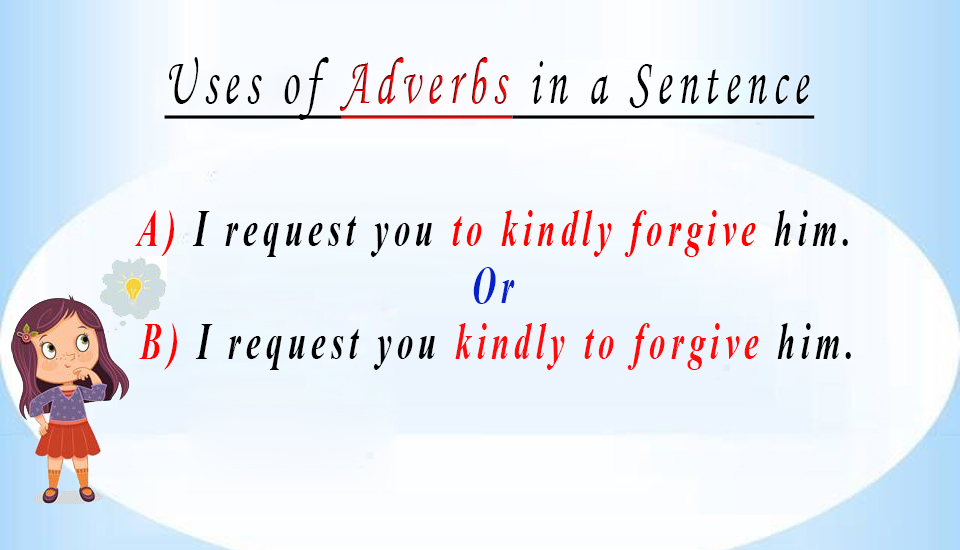An adverb as like a verb can be a significant part of a sentence. Adverbs play a vital rule in a sentence, they are used to change or qualify the meaning of an adjective, a verb, a clause or another adverb in a sentence. In the lesson below we will look at the uses of adverbs in a sentence.
Uses of Adverbs in a Sentence
What is an Adverb?
An adverb adds something to the meaning of adjective, verb and any other adverb but not a noun or pronoun.
- He works carefully. (How does he work? Carefully, describes the verb “works”).
- It was a very difficult job. (How difficult was the job? Very difficult, describes the adjective difficult).
- He completed the job quite carefully. (How carefully did he complete the job? Quite carefully, describes the adverb “carefully”).
Sometimes an adverb modifies an entire assertive sentence. In such cases, the adverb must stand first in the sentence.
- Certainly, I will help him.
- Unfortunately, the doctor came late.
Position of adverbs:
The position of adverb in a sentence is governed by the following considerations:
1. An adverb usually comes before an adjective or another adverb.
- She was very glad to see you.
- They fought very bravely.
(“Enough” is generally placed after the word it modifies).
- He was rich enough to travel first class.
- This house is large enough for us.
2. An adverb is usually placed after the verb it modifies. But, for the sake of emphasis, it may also be placed before that verb.
- He came late. (“Late” modifies the verb “came”)
- She never tells lie. (“Never” modifies “tells”)
Similarly, adverb of time (always, ever, often, seldom, and sometime) and number (first, one, ten etc.) are usually placed before the verb they modify (except to be verbs).
- You seldom do your duty.
- He always played me false.
- She is seldom late.
3. An adverb comes either before or after the object, but not at all between the transitive verb and its object.
- I learn my lesson thoroughly.
- I thoroughly learn my lesson.
4. An adverb may come between an incomplete verb and its complement.
- He is certainly a miser.
This is quit wrong.
5. An adverb comes either before or after the object, but not between the transitive verb and its object.
- I will always do my duty.
- He has never deceived us.
6. An adverb is placed first in a sentence where it qualifies the whole sentence, and secondly it emphasizes, or for exclamation.
- Fortunately, no one was hurt. (Qualifies whole sentence)
- Of course, he does the job. (For emphasis)
- What a nice car it is! (For exclamation)
Some important points about the uses of adverbs
1. Some adverbs, unless placed immediately before the words they modify, change the sense of the sentence.
- He only buys pictorial magazines these days. (“Buys” but does not “read”)
- He buys only pictorial magazines these days. (“Buys” no magazine that is not “pictorial”)
- He buys pictorial magazines only these days. (Did not buy ever “before”)
2. Some adverbs have two forms with different meanings and therefore, should be used with great care.
- I went direct (adverb) to the Manager.
- No action was taken directly. (adverb)
- Books were given free (adverb).
He moved freely (adverb) among the guests.
3. An adverb is not placed between an infinitive and its sign “to”.
- I request you to kindly forgive him. (Incorrect)
- I request you kindly to forgive him. (Correct)
Three distinct kinds of adverbs
1. The simple adverbs: They qualify the meanings of the words to which they are attached.
- He came quickly.
- Do it well.
- She moved slowly.
a. Adverb of Time: (after, now, again, already, ago, later etc.)
b. Adverb of place: (above, around, aside, everywhere etc.)
c. Adverb of degree/quantity: (almost, also, enough, little, much, too, very etc.)
d. Adverb of manner/quality/state: (so, certainly, slowly, well, badly, fast etc.)
e. Adverb of number: (firstly, never, once, often, twice etc.)
f. Adverb of cause: (how, why, what)
g. Adverb of comparison: (so, as, than)
2. The relative adverbs: They not only qualify any part of speech except a noun or a pronoun but also connect sentences. (As, how, then, when, where, while, why, whereas, and whereby)
- I do not know where he lives.
3. The interrogative adverbs: They are the same in form as the relative pronouns, but they are used in asking questions (Where, when, why, how far and how long)
- Where did you go?
- When did she complete her homework?
In this lesson you learned about the uses of adverbs in a sentence. you can click on the link to learn about the comparisons of adverbs. Hope you will uses the adverbs correctly in your sentences so on. If you have any question please feel free to comment the comment box below.

